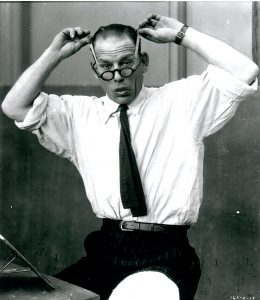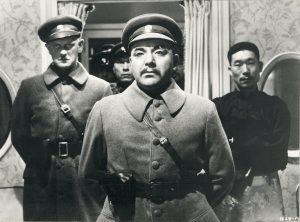Q&A With "Made-Up Asians" Author Esther Kim Lee

This guest author post is a Q&A with Esther Kim Lee, author of Made-Up Asians: Yellowface During the Exclusion Era , from the University of Michigan Press. This book is available in hardcover, paperback, and ebook.
What was the inspiration behind Made-Up Asians ? What surprised you the most while conducting your research for the book?
For my first book, A History of Asian American Theatre (2006), I interviewed over seventy Asian American theater artists, including actors, playwrights, directors, producers, and designers. While conducting the interviews, I noticed almost everyone mentioned yellowface as something that they were reacting against in their work, and many–especially actors–got started in Asian American theater to specifically fight against yellowface. I realized that yellowface has functioned as an origin story of Asian American theater; the artistic movement we now define as “Asian American theater” got started because of the need to fight against yellowface. The first Asian American theater company, the East West Players , was founded in 1965 in Los Angeles by a group of actors who wanted to present non-stereotypical images of Asians and to provide better job opportunities for Asian American actors. After writing the first book, I continued to think about the possibility of connecting yellowface history to Asian American theater history. In a way, Made-Up Asians is a prequel to the first book. Importantly, the book is the first to document the history of yellowface and to explain what Asian American theater artists were working against starting in the mid-twentieth century.
In what ways has yellowface technology excluded Asian/Asian American actors?
In the nineteenth century, yellowface was one of dozens of racial, ethnic, national theatrical makeup described as “character makeup.” Such makeup included European nationalities such as German and Irish as well as ethnic groups like Jews. Blackface was also part of the “character makeup” convention. All of these makeup types were created for white actors or actors who could pass as white. I studied many theatrical makeup guidebooks for the book, and all of them were written explicitly for white actors. In contrast to “character makeup” which was used to mark human differences, “straight makeup” was used by white actors to play white characters. The guidebooks make this distinction very clear. What this means is that in the U. S. acting industry, since its beginning, “The Actor” was understood to be white as a default. White actors were allowed to play the full range of character types, but non-white actors were limited to playing their own ethnic/racial/national types. In other words, a white male actor could play Othello, Romeo, and a Chinese man all in one theatrical season, but a Chinese actor could only play secondary East Asian characters. White actors were assumed to be more versatile and capable of portraying the full human experience, while non-white actors were seen as being limited by their own supposed inferiority and lack of artistry. Principal Asian roles went to white actors in yellowface, many of whom used the opportunity to become star actors and gain fame and money. Asian actors, on the other hand, had to play secondary and extra roles. It is in this sense that yellowface technology was used to exclude Asian and Asian American actors. Actors such as Anna May Wong were told that they were not cast to play Asian lead roles precisely because they were Asian.
In your book, you speak to the “normalization of yellowface,” and its durability. Why do you think yellowface has been able to persist for so long within performance, and Western culture at large?
In 1960, the actor Makato Iwamatsu (Mako, 1933-2006) auditioned for the role of the bandit in the television version of Rashomon , a play written by Fay and Michael Kanin based on Japanese stories. Because the story of Rashomon is Japanese, takes place in Japan, and features Japanese characters, Mako thought he had a good chance. A Japanese-born actor who studied acting at the Pasadena Playhouse, Mako knew the role was a rare opportunity. He had received many rejections at auditions because of his ethnicity, and it made logical sense for him to play a role that looked like him. However, after his audition, the casting director of Rashomon told him, “You gave a great reading, but as a real Japanese, you’d be too conspicuous. All of the other actors are white made up to look Japanese.” The role of the bandit was ultimately played by the Mexican-born actor Ricardo Montalbán (1920-2009) in yellowface makeup. He, along with the rest of the cast, wore prosthetics on the eyes, darkened the skin, and wore costumes to look Japanese. By 1960, yellowface was so normalized in the acting industry that Asian actors were seen as too Asian to play Asian roles. This anecdote goes to the heart of how yellowface had become the default way, or the blueprint, to represent Asians onstage and onscreen by the mid-twentieth century. Yellowface has persisted because it has been an integral part of the U. S. acting industry. In that industry, yellowface has been an effective way to promote star white actors and to profit from representing Asians and Asia in fantastical, exotic, and imagined ways. Real Asians were legally excluded from immigration and citizenship during much of U. S. history, and such exclusionary laws were represented through white actors in yellowface in theater and film. In the acting industry, real Asian actors were excluded while non-Asian actors portrayed what was promoted as real but was, ultimately, made-up both through imagination and theatrical make-up.
Do you think theater and Hollywood are coming to terms with these exclusionary practices?
The most recent incidences of yellowface controversy
(e.g. Scarlett Johansson in the 2016 film Ghost in a Shell and Emma Stone in the 2015 film in Aloha ) received a lot of attention on social media, and there has not been another major film with yellowface since then. However, if another yellowface controversy erupts in the near future, I don’t think I would be surprised. Both theater and Hollywood as industries have poor short-term memory, and racial casting controversies come and go in cycles. Overall, I am not very optimistic about the industries coming to terms with the convention of yellowface. I tried to provide a clear explanation of how yellowface has been a technology of exclusion, but there will be people who insist on pushing the idea that yellowface, somehow, honors Asians or that it cannot be avoided because there are no A-list star actors who are Asian. Unless the entirety of the industries can make radical changes to be less exclusionary, yellowface will continue to persist.
What do you hope readers will take away from reading Made-Up Asians?
I am a theater historian, and in writing the book, I wanted to underscore both theater and history as sites of investigation. Many people think yellowface began with film and point to examples from the early twentieth century as the starting point. However, my book demonstrates that yellowface actually began in theater centuries prior to the invention of film and that it was imported from European theater during the Colonial America era. Yellowface is a theatrical makeup convention that began in theater and was later developed for film by makeup artists as a special effects makeup. The underscoring of history points to not only the importance of archival research and historical narratives in the book but also to how I incorporate historiographical questions. My goal with the book is to introduce what yellowface is as a historical subject and how it can be made known. This is why I make an effort to provide a taxonomy of yellowface by identifying different types of yellowface such as clown yellowface, cosmetic yellowface, and prosthetic yellowface. I also emphasize how yellowface was practiced as a technology and as embodied knowledge. My hope is that by making yellowface known as a historical subject, we will understand it not as a harmless act of playmaking but as a consequential extension of Asian exclusion.





